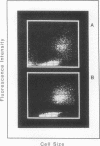Abstract
A series of monoclonal antibodies have been characterized that define four surface antigens (MY3, MY4, MY7, and MY8) of human myeloid cells. They were derived from a fusion of the NS-1 plasmacytoma cell line with splenocytes from a mouse immunized with human acute myelomonocytic leukemia cells. MY3 and MY4 are expressed by normal monocytes and by greater than 90% of patients with acute monocytic leukemia or acute myelomonocytic leukemia, but are detected much less often on other types of myeloid leukemia. MY7 is expressed by granulocytes, monocytes, and 5% of normal bone marrow cells. 79% of all acute myeloblastic leukemia (AML) patients tested (72 patients) express MY7 without preferential expression by any AML subtype. MY8 is expressed by normal monocytes, granulocytes, all peroxidase-positive bone marrow cells, and 50% of AML patients. MY3, MY4, and MY8 define myeloid differentiation antigens in that they are not detected on myeloid precursor cells and appear at discrete stages of differentiation. These antigens are not expressed by lymphocytes, erythrocytes, platelets, or lymphoid malignancies. The monoclonal antisera defining these antigens have been used to study differentiation of normal myeloid cells and malignant cell lines.
Full text
PDF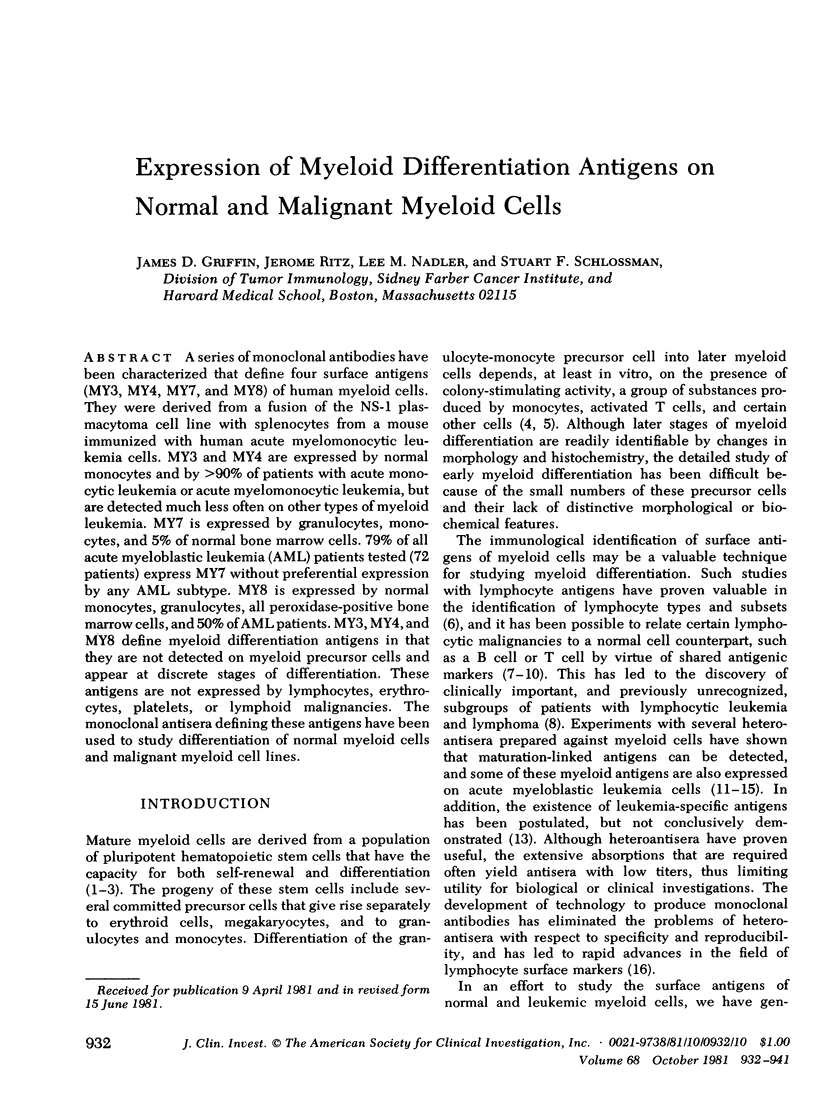
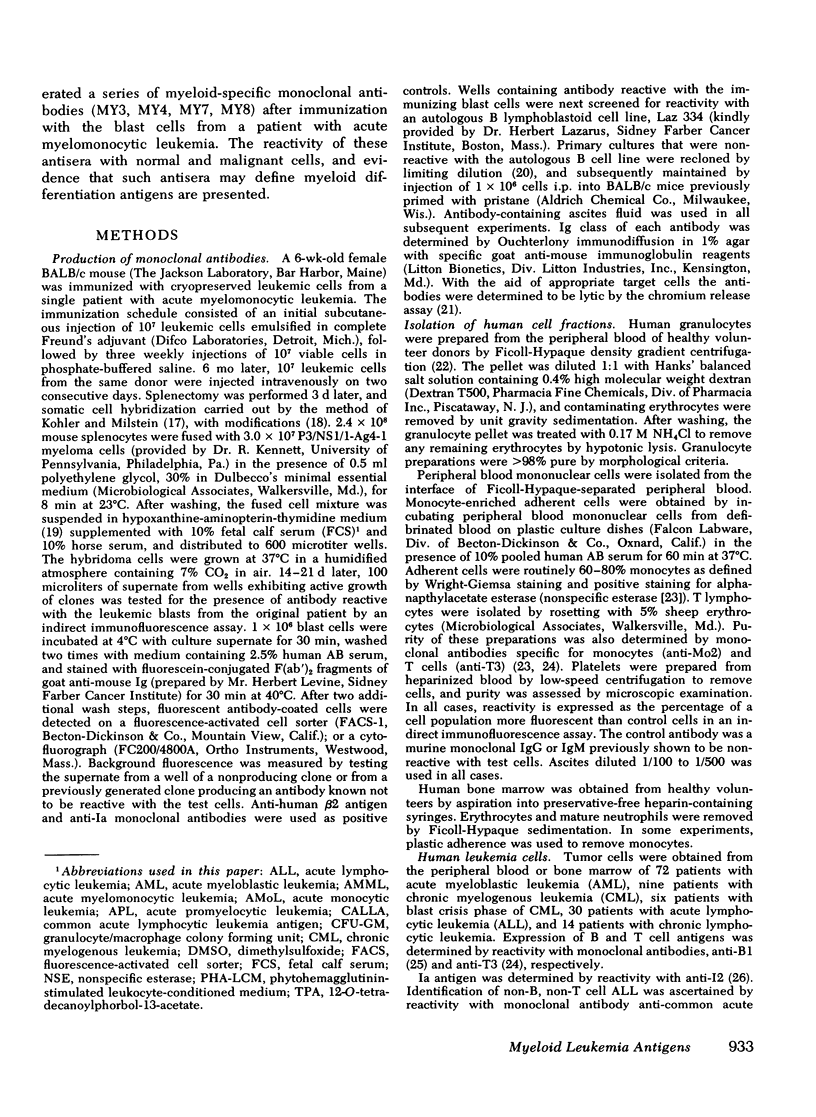
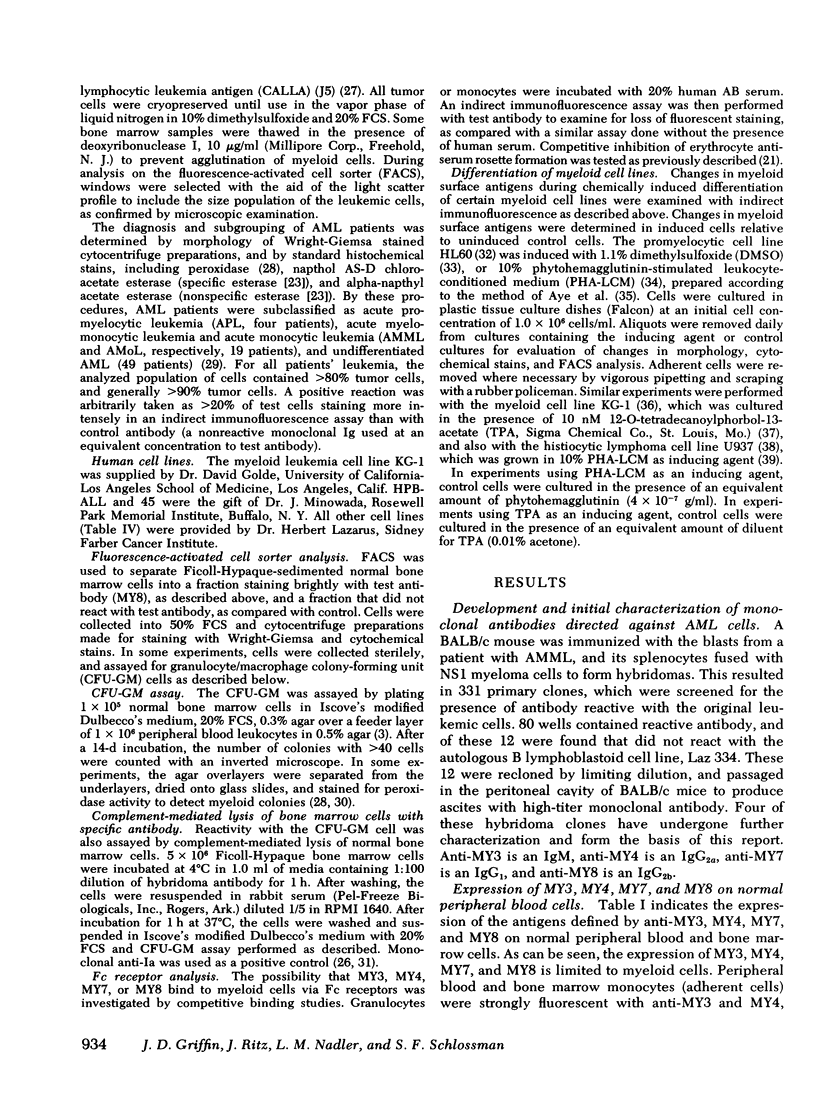
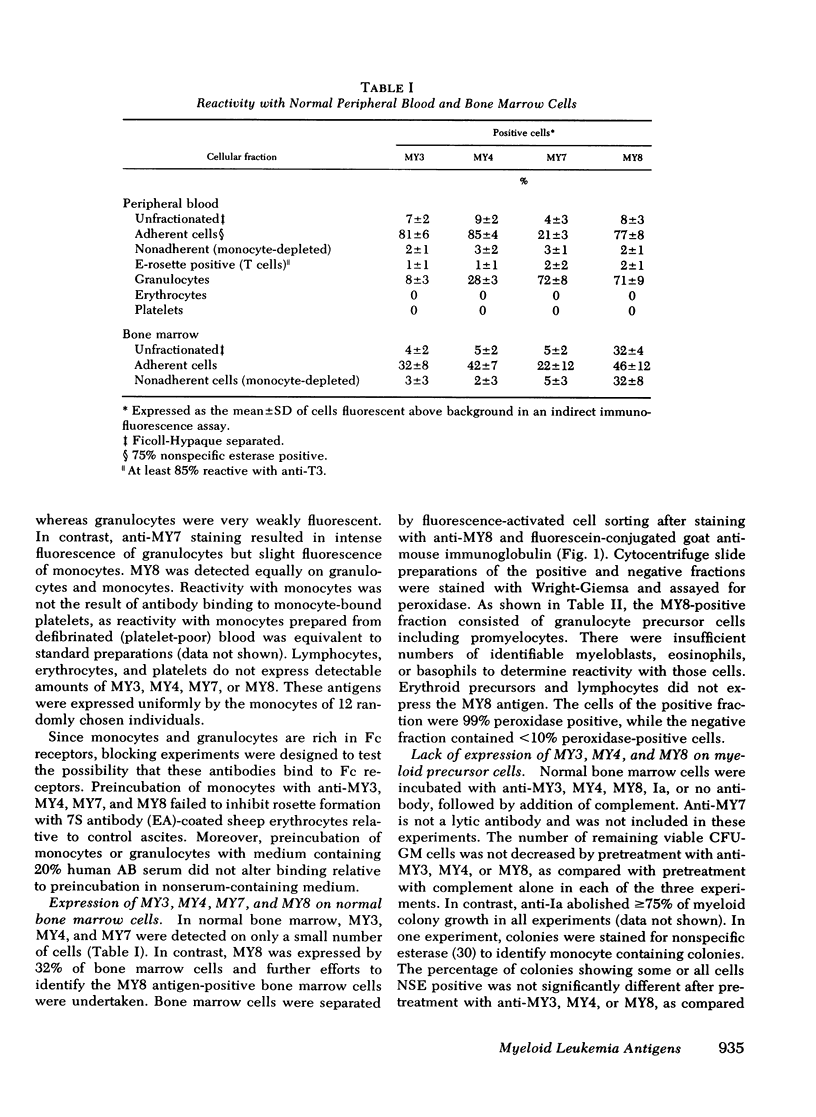
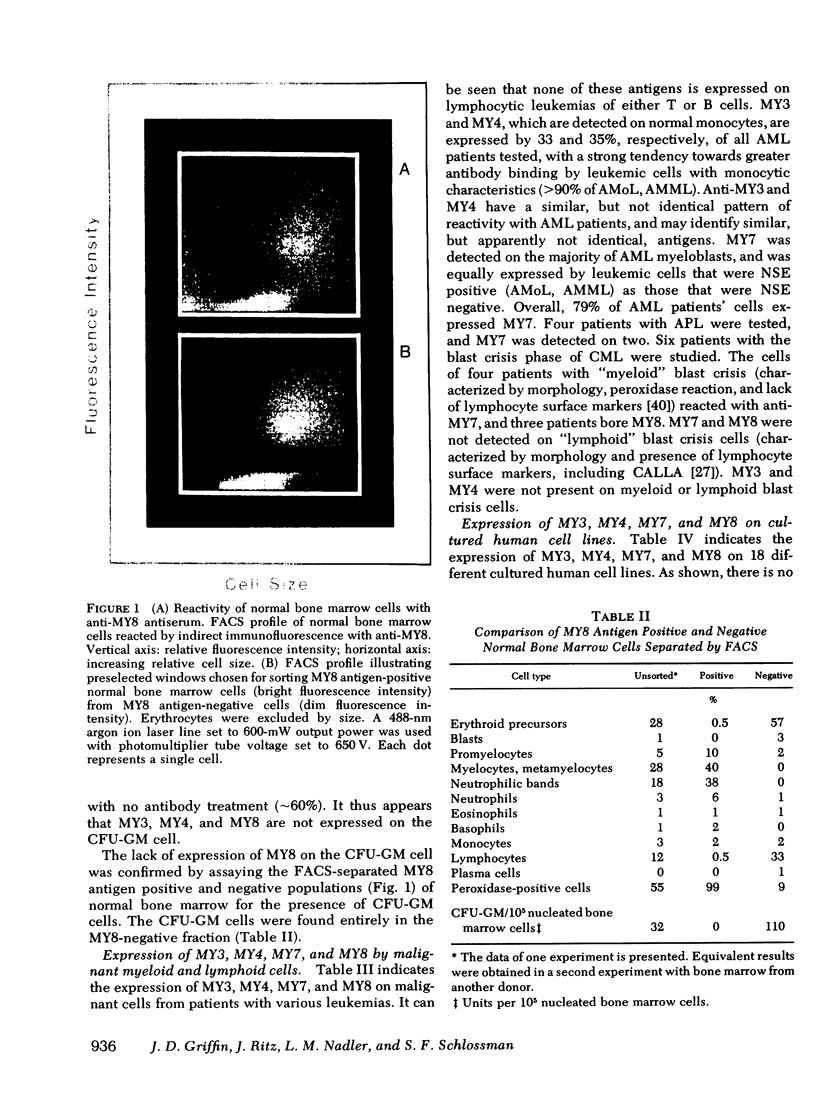
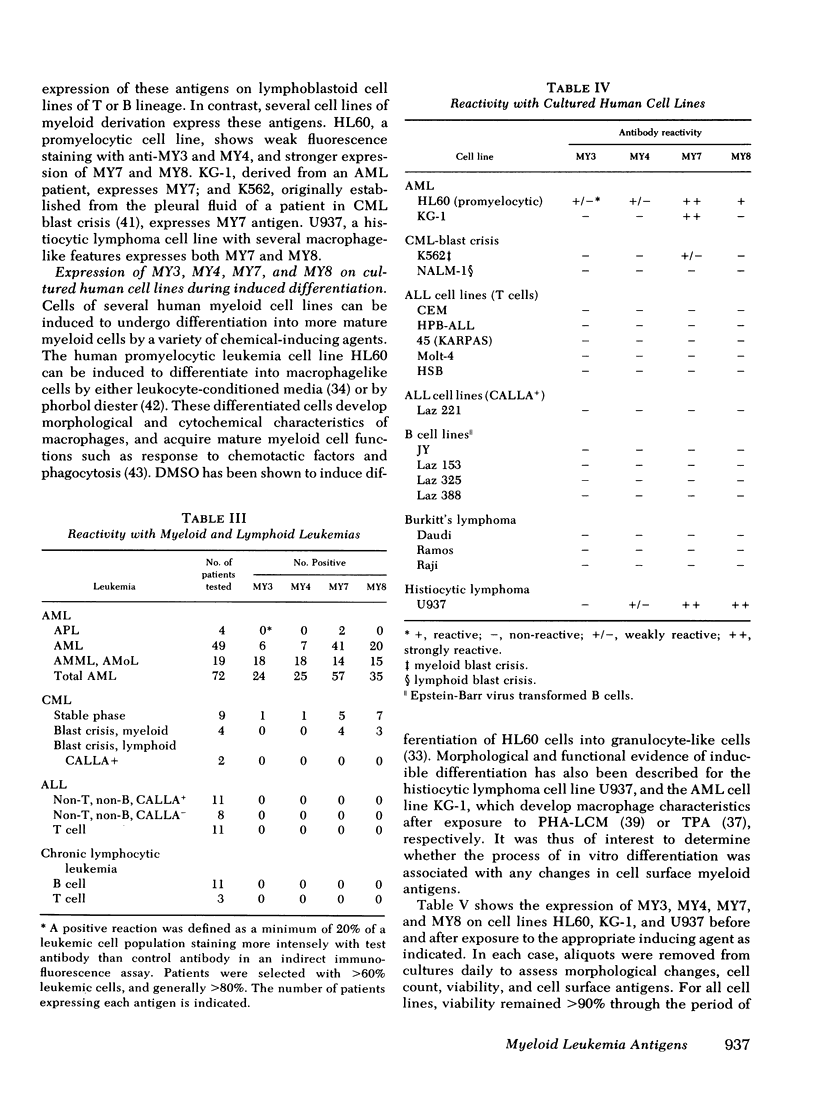
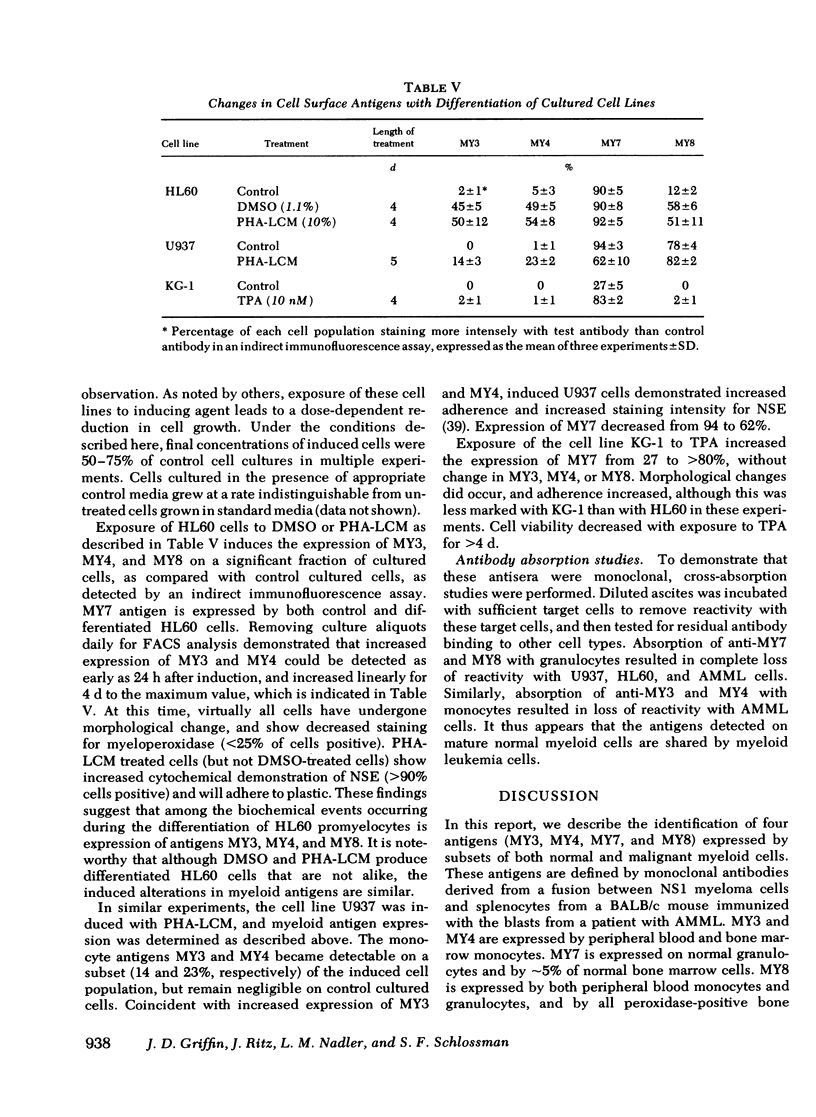
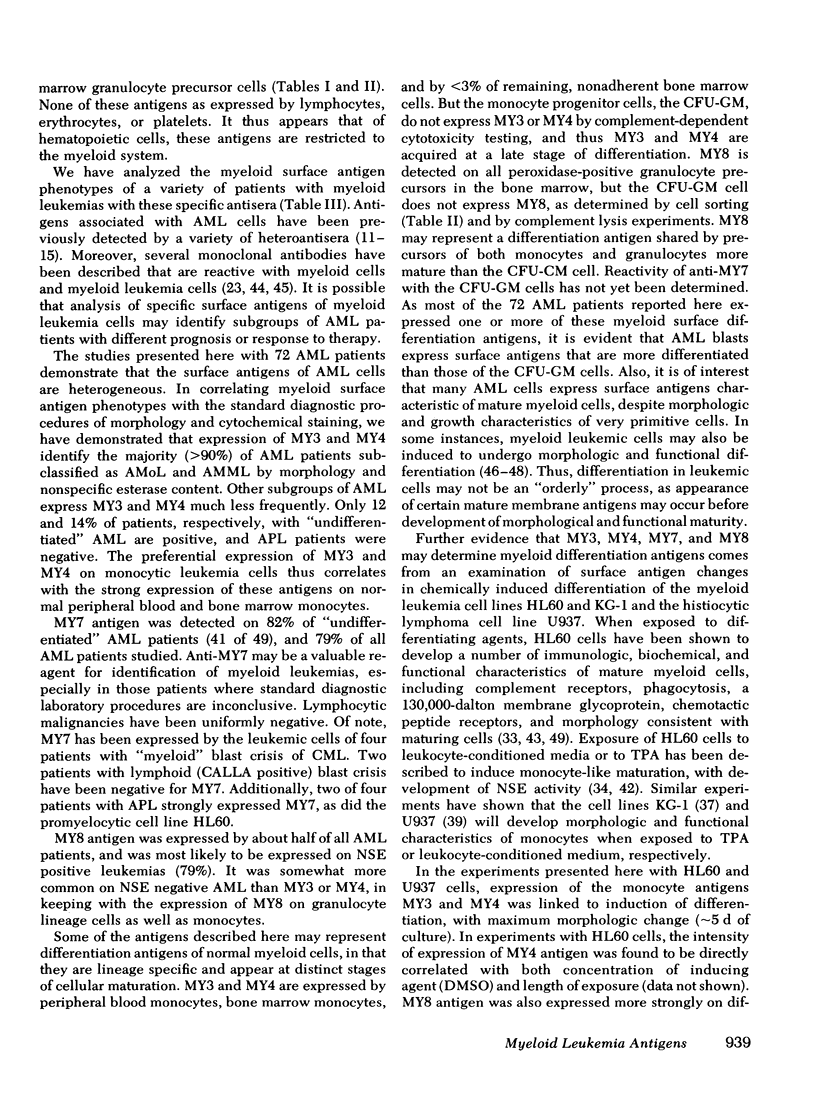
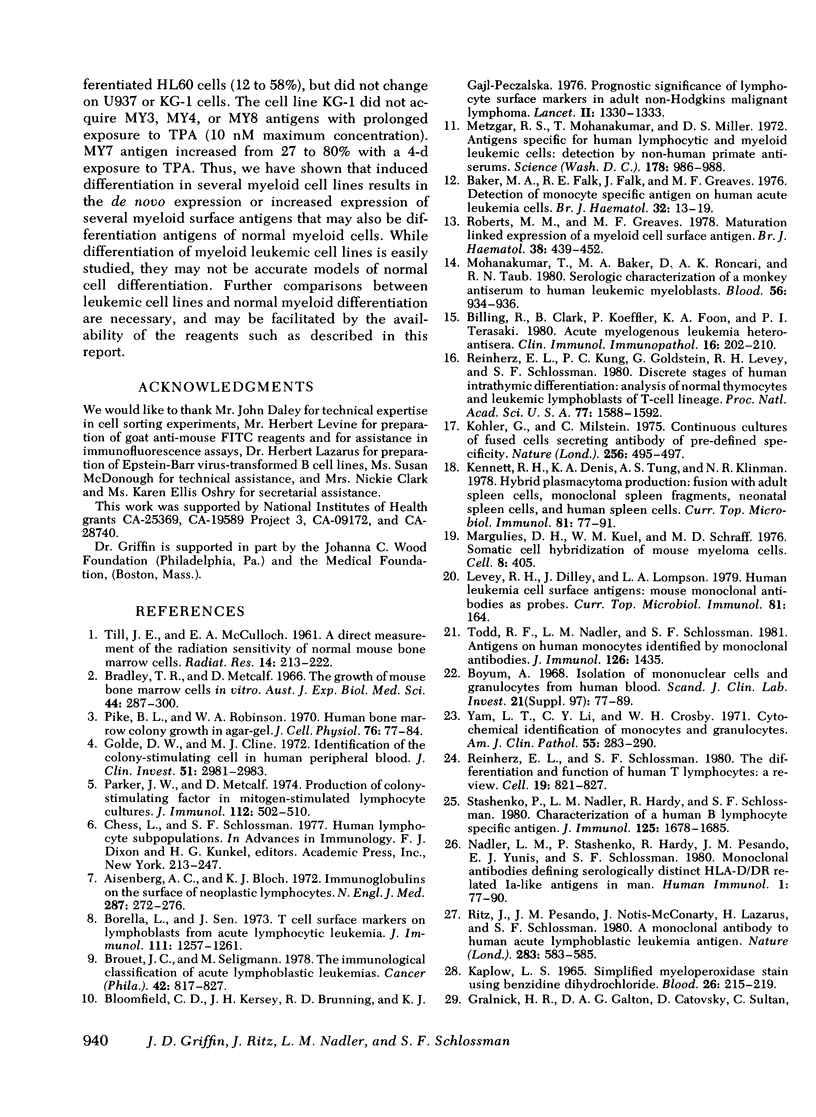
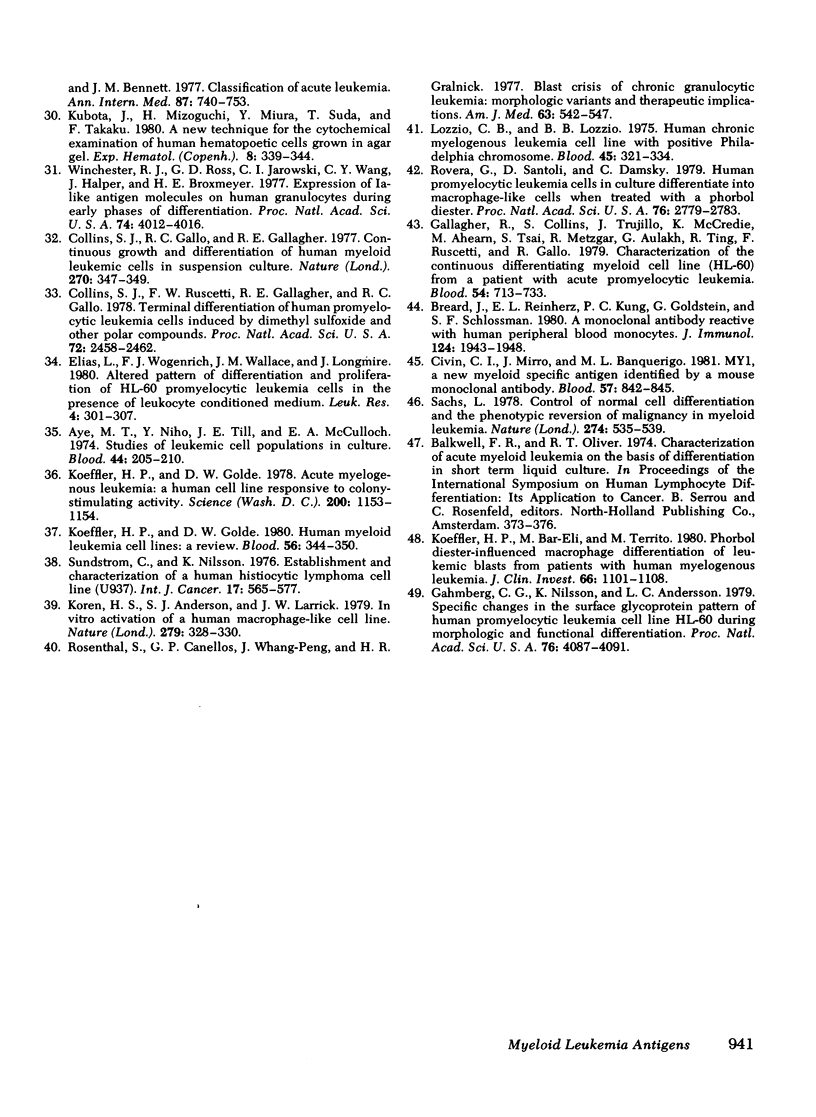
Images in this article
Selected References
These references are in PubMed. This may not be the complete list of references from this article.
- Aisenberg A. C., Bloch K. J. Immunoglobulins on the surface of neoplastic lymphocytes. N Engl J Med. 1972 Aug 10;287(6):272–276. doi: 10.1056/NEJM197208102870603. [DOI] [PubMed] [Google Scholar]
- Andreotti P. E., Apgar J. R., Cresswell P. HLA-A2 as a target for cell-mediated lympholysis: evidence from immunoselected HLA-A2 negative mutant cell lines. Hum Immunol. 1980 Jul;1(1):77–86. doi: 10.1016/0198-8859(80)90011-7. [DOI] [PubMed] [Google Scholar]
- Aye M. T., Niho Y., Till J. E., McCulloch E. A. Studies of leukemic cell populations in culture. Blood. 1974 Aug;44(2):205–219. [PubMed] [Google Scholar]
- Baker M. A., Falk R. E., Falk J., Greaves M. F. Detection of monocyte specific antigen on human acute leukaemia cells. Br J Haematol. 1976 Jan;32(1):13–19. doi: 10.1111/j.1365-2141.1976.tb01870.x. [DOI] [PubMed] [Google Scholar]
- Billing R., Clark B., Koeffler P., Foon K. A., Terasaki P. I. Acute myelogenous leukemia heteroantisera. Clin Immunol Immunopathol. 1980 Jun;16(2):202–210. doi: 10.1016/0090-1229(80)90204-4. [DOI] [PubMed] [Google Scholar]
- Bloomfield C. D., Kersey J. H., Brunning R. D., Gajl-Peczalska K. J. Prognostic significance of lymphocyte surface markers in adult non-Hodgkin's malignant lymphoma. Lancet. 1976 Dec 18;2(7999):1330–1333. doi: 10.1016/s0140-6736(76)91976-0. [DOI] [PubMed] [Google Scholar]
- Borella L., Sen L. T cell surface markers on lymphoblasts from acute lymphocytic leukemia. J Immunol. 1973 Oct;111(4):1257–1260. [PubMed] [Google Scholar]
- Bradley T. R., Metcalf D. The growth of mouse bone marrow cells in vitro. Aust J Exp Biol Med Sci. 1966 Jun;44(3):287–299. doi: 10.1038/icb.1966.28. [DOI] [PubMed] [Google Scholar]
- Breard J., Reinherz E. L., Kung P. C., Goldstein G., Schlossman S. F. A monoclonal antibody reactive with human peripheral blood monocytes. J Immunol. 1980 Apr;124(4):1943–1948. [PubMed] [Google Scholar]
- Brouet J. C., Seligmann M. The immunological classification of acute lymphoblastic leukemias. Cancer. 1978 Aug;42(2 Suppl):817–827. doi: 10.1002/1097-0142(197808)42:2+<817::aid-cncr2820420703>3.0.co;2-2. [DOI] [PubMed] [Google Scholar]
- Böyum A. Isolation of mononuclear cells and granulocytes from human blood. Isolation of monuclear cells by one centrifugation, and of granulocytes by combining centrifugation and sedimentation at 1 g. Scand J Clin Lab Invest Suppl. 1968;97:77–89. [PubMed] [Google Scholar]
- Civin C. I., Mirro J., Banquerigo M. L. My-1, new myeloid-specific antigen identified by a mouse monoclonal antibody. Blood. 1981 May;57(5):842–845. [PubMed] [Google Scholar]
- Classification of acute leukemia. Ann Intern Med. 1977 Dec;87(6):740–753. doi: 10.7326/0003-4819-87-6-740. [DOI] [PubMed] [Google Scholar]
- Collins S. J., Gallo R. C., Gallagher R. E. Continuous growth and differentiation of human myeloid leukaemic cells in suspension culture. Nature. 1977 Nov 24;270(5635):347–349. doi: 10.1038/270347a0. [DOI] [PubMed] [Google Scholar]
- Collins S. J., Ruscetti F. W., Gallagher R. E., Gallo R. C. Terminal differentiation of human promyelocytic leukemia cells induced by dimethyl sulfoxide and other polar compounds. Proc Natl Acad Sci U S A. 1978 May;75(5):2458–2462. doi: 10.1073/pnas.75.5.2458. [DOI] [PMC free article] [PubMed] [Google Scholar]
- Elias L., Wogenrich F. J., Wallace J. M., Longmire J. Altered pattern of differentiation and proliferation of HL-60 promyelocytic leukemia cells in the presence of leucocyte conditioned medium. Leuk Res. 1980;4(3):301–307. doi: 10.1016/0145-2126(80)90037-5. [DOI] [PubMed] [Google Scholar]
- Gahmberg C. G., Nilsson K., Andersson L. C. Specific changes in the surface glycoprotein pattern of human promyelocytic leukemic cell line HL-60 during morphologic and functional differentiation. Proc Natl Acad Sci U S A. 1979 Aug;76(8):4087–4091. doi: 10.1073/pnas.76.8.4087. [DOI] [PMC free article] [PubMed] [Google Scholar]
- Gallagher R., Collins S., Trujillo J., McCredie K., Ahearn M., Tsai S., Metzgar R., Aulakh G., Ting R., Ruscetti F. Characterization of the continuous, differentiating myeloid cell line (HL-60) from a patient with acute promyelocytic leukemia. Blood. 1979 Sep;54(3):713–733. [PubMed] [Google Scholar]
- Golde D. W., Cline M. J. Identification of the colony-stimulating cell in human peripheral blood. J Clin Invest. 1972 Nov;51(11):2981–2983. doi: 10.1172/JCI107124. [DOI] [PMC free article] [PubMed] [Google Scholar]
- KAPLOW L. S. SIMPLIFIED MYELOPEROXIDASE STAIN USING BENZIDINE DIHYDROCHLORIDE. Blood. 1965 Aug;26:215–219. [PubMed] [Google Scholar]
- Kennett R. H., Denis K. A., Tung A. S., Klinman N. R. Hybrid plasmacytoma production: fusions with adult spleen cells, monoclonal spleen fragments, neonatal spleen cells and human spleen cells. Curr Top Microbiol Immunol. 1978;81:77–91. doi: 10.1007/978-3-642-67448-8_13. [DOI] [PubMed] [Google Scholar]
- Koeffler H. P., Bar-Eli M., Territo M. Phorbol diester-induced macrophage differentiation of leukemic blasts from patients with human myelogenous leukemia. J Clin Invest. 1980 Nov;66(5):1101–1108. doi: 10.1172/JCI109939. [DOI] [PMC free article] [PubMed] [Google Scholar]
- Koeffler H. P., Golde D. W. Acute myelogenous leukemia: a human cell line responsive to colony-stimulating activity. Science. 1978 Jun 9;200(4346):1153–1154. doi: 10.1126/science.306682. [DOI] [PubMed] [Google Scholar]
- Koeffler H. P., Golde D. W. Human myeloid leukemia cell lines: a review. Blood. 1980 Sep;56(3):344–350. [PubMed] [Google Scholar]
- Koren H. S., Anderson S. J., Larrick J. W. In vitro activation of a human macrophage-like cell line. Nature. 1979 May 24;279(5711):328–331. doi: 10.1038/279328a0. [DOI] [PubMed] [Google Scholar]
- Kubota K., Mizoguchi H., Miura Y., Suda T., Takaku F. A new technique for the cytochemical examination of human hemopoietic cells grown in agar gel. Exp Hematol. 1980 Mar;8(3):339–344. [PubMed] [Google Scholar]
- Köhler G., Milstein C. Continuous cultures of fused cells secreting antibody of predefined specificity. Nature. 1975 Aug 7;256(5517):495–497. doi: 10.1038/256495a0. [DOI] [PubMed] [Google Scholar]
- Levy R., Dilley J., Lampson L. A. Human normal and leukemia cell surface antigens. Mouse monoclonal antibodies as probes. Curr Top Microbiol Immunol. 1978;81:164–169. doi: 10.1007/978-3-642-67448-8_26. [DOI] [PubMed] [Google Scholar]
- Lozzio C. B., Lozzio B. B. Human chronic myelogenous leukemia cell-line with positive Philadelphia chromosome. Blood. 1975 Mar;45(3):321–334. [PubMed] [Google Scholar]
- Margulies D. H., Kuehl W. M., Scharff M. D. Somatic cell hybridization of mouse myeloma cells. Cell. 1976 Jul;8(3):405–415. doi: 10.1016/0092-8674(76)90153-7. [DOI] [PubMed] [Google Scholar]
- Metzgar R. S., Mohanakumar T., Miller D. S. Antigens specific for human lymphocytic and myeloid leukemia cells: detection by nonhuman primate antiserums. Science. 1972 Dec 1;178(4064):986–988. doi: 10.1126/science.178.4064.986. [DOI] [PubMed] [Google Scholar]
- Mohanakumar T., Baker M. A., Roncari D. A., Taub R. N. Serologic characterization of a monkey antiserum to human leukemic myeloblasts. Blood. 1980 Nov;56(5):934–936. [PubMed] [Google Scholar]
- Parker J. W., Metcalf D. Production of colony-stimulating factor in mitogen-stimulated lymphocyte cultures. J Immunol. 1974 Feb;112(2):502–510. [PubMed] [Google Scholar]
- Pike B. L., Robinson W. A. Human bone marrow colony growth in agar-gel. J Cell Physiol. 1970 Aug;76(1):77–84. doi: 10.1002/jcp.1040760111. [DOI] [PubMed] [Google Scholar]
- Reinherz E. L., Kung P. C., Goldstein G., Levey R. H., Schlossman S. F. Discrete stages of human intrathymic differentiation: analysis of normal thymocytes and leukemic lymphoblasts of T-cell lineage. Proc Natl Acad Sci U S A. 1980 Mar;77(3):1588–1592. doi: 10.1073/pnas.77.3.1588. [DOI] [PMC free article] [PubMed] [Google Scholar]
- Reinherz E. L., Schlossman S. F. The differentiation and function of human T lymphocytes. Cell. 1980 Apr;19(4):821–827. doi: 10.1016/0092-8674(80)90072-0. [DOI] [PubMed] [Google Scholar]
- Ritz J., Pesando J. M., Notis-McConarty J., Lazarus H., Schlossman S. F. A monoclonal antibody to human acute lymphoblastic leukaemia antigen. Nature. 1980 Feb 7;283(5747):583–585. doi: 10.1038/283583a0. [DOI] [PubMed] [Google Scholar]
- Roberts M. M., Greaves M. F. Maturation linked expression of a myeloid cell surface antigen. Br J Haematol. 1978 Apr;38(4):439–452. doi: 10.1111/j.1365-2141.1978.tb01069.x. [DOI] [PubMed] [Google Scholar]
- Rosenthal S., Canellos G. P., Whang-Peng J., Gralnick H. R. Blast crisis of chronic granulocytic leukemia. Morphologic variants and therapeutic implications. Am J Med. 1977 Oct;63(4):542–547. doi: 10.1016/0002-9343(77)90199-1. [DOI] [PubMed] [Google Scholar]
- Rovera G., Santoli D., Damsky C. Human promyelocytic leukemia cells in culture differentiate into macrophage-like cells when treated with a phorbol diester. Proc Natl Acad Sci U S A. 1979 Jun;76(6):2779–2783. doi: 10.1073/pnas.76.6.2779. [DOI] [PMC free article] [PubMed] [Google Scholar]
- Sachs L. Control of normal cell differentiation and the phenotypic reversion of malignancy in myeloid leukaemia. Nature. 1978 Aug 10;274(5671):535–539. doi: 10.1038/274535a0. [DOI] [PubMed] [Google Scholar]
- Stashenko P., Nadler L. M., Hardy R., Schlossman S. F. Characterization of a human B lymphocyte-specific antigen. J Immunol. 1980 Oct;125(4):1678–1685. [PubMed] [Google Scholar]
- Sundström C., Nilsson K. Establishment and characterization of a human histiocytic lymphoma cell line (U-937). Int J Cancer. 1976 May 15;17(5):565–577. doi: 10.1002/ijc.2910170504. [DOI] [PubMed] [Google Scholar]
- TILL J. E., McCULLOCH E. A. A direct measurement of the radiation sensitivity of normal mouse bone marrow cells. Radiat Res. 1961 Feb;14:213–222. [PubMed] [Google Scholar]
- Todd R. F., 3rd, Nadler L. M., Schlossman S. F. Antigens on human monocytes identified by monoclonal antibodies. J Immunol. 1981 Apr;126(4):1435–1442. [PubMed] [Google Scholar]
- Winchester R. J., Ross G. D., Jarowski C. I., Wang C. Y., Halper J., Broxmeyer H. E. Expression of Ia-like antigen molecules on human granulocytes during early phases of differentiation. Proc Natl Acad Sci U S A. 1977 Sep;74(9):4012–4016. doi: 10.1073/pnas.74.9.4012. [DOI] [PMC free article] [PubMed] [Google Scholar]
- Yam L. T., Li C. Y., Crosby W. H. Cytochemical identification of monocytes and granulocytes. Am J Clin Pathol. 1971 Mar;55(3):283–290. doi: 10.1093/ajcp/55.3.283. [DOI] [PubMed] [Google Scholar]



